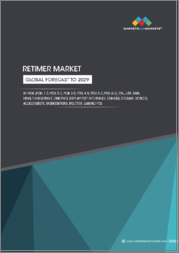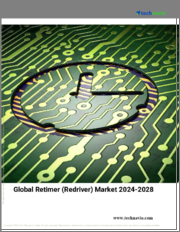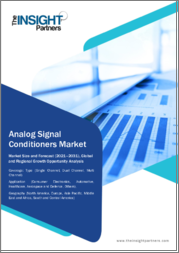
|
시장보고서
상품코드
1676689
세계의 리타이머 시장 : 인터페이스 규격별, 기술별, 전송 매체별, 판매 채널별, 용도별, 예측(2025-2030년)Retimer Market by Interface Standard, Technology, Transmission Medium, Sales Channel, Application - Global Forecast 2025-2030 |
||||||
리타이머 시장의 2023년 시장 규모는 12억 6,000만 달러로 평가되었습니다. 2024년에는 13억 7,000만 달러에 달했습니다. 예측 기간 동안 CAGR 9.74%를 나타낼 전망이며, 2030년에는 24억 1,000만 달러에 이를 것으로 예측되고 있습니다.
| 주요 시장 통계 | |
|---|---|
| 기준 연도(2023년)년 | 12억 6,000만 달러 |
| 추정 연도(2024년) | 13억 7,000만 달러 |
| 예측 연도2030 | 24억 1,000만 달러 |
| CAGR(%) | 9.74% |
리타이머 시장은 급속한 기술 진보와 각 업계의 중요한 수요 변화에 힘입어 전례없는 진화의 시대를 맞이하고 있습니다. 이 입문적인 개요는 고속 데이터 전송의 끊임없는 개선과 현대 컴퓨팅 시스템의 신뢰성에 대한 요구가 커짐에 따라 상황을 정의합니다. 최첨단 인터페이스, 최적화된 용도, 향상된 성능 기능의 통합은 장치 통신 및 협업 방식을 바꾸고 있습니다.
이 입문서에서는 리타이머 기술의 중요성과 오늘날의 데이터 전송 문제를 해결하기 위해 수행하는 역할에 대해 설명합니다. 데이터센터, 소비자 일렉트로닉스, 자동차, 산업 자동화, 통신 등 업계가 끊임없는 혁신을 겪고 있는 가운데, 리타이머 시장은 고해상도 연결과 확장 가능한 성능에 대한 기대치를 높이기 위해 진화하고 있습니다. 이 보고서는 주요 동향과 변화를 분석하여 시장 세분화, 세계 지역 동향, 기업의 전략적 인사이트 등 심층 분석 무대를 제공합니다.
이 시장의 역동적인 특성으로 인해 업계 리더와 의사결정자들은 데이터의 충실성을 높일 뿐만 아니라 급변하는 기술적 배경에서 경쟁 우위를 높이는 혁신에 주력해야 합니다. 이 종합적인 분석을 통해 시장 성장을 가속하는 근본적인 요인을 밝히고 다음 섹션에서 자세히 설명하기 위한 견고한 기반을 수립합니다.
리타이머 상황에서 변혁적 변화
진화하는 디지털 에코시스템은 신기술이 기존의 데이터 통신의 패러다임을 파괴하고 리타이머 상황에 변화를 가져오고 있습니다. 하드웨어 설계 및 제조의 중요한 발전은 멀티 인터페이스 시스템의 급속한 통합과 함께 성능 벤치마크와 신뢰성 기준을 재정의했습니다. 이러한 진화는 R&D 투자 증가, 제품 출시 가속화, 복잡한 데이터 과제에 대한 대응을 목표로 하는 전략적 제휴로 현저하게 나타납니다.
최근 속도 최적화와 에너지 효율 개발 동향은 엄격한 운영 조건 하에서도 견고한 성능을 발휘하는 시스템에 시장 관점을 향하고 있습니다. 용도의 복잡성과 데이터 양이 급격히 증가함에 따라 시장의 요구가 계속 증가함에 따라 제조업체는 기존의 전송 매체와 최신 고속 연결 표준 간의 격차를 메우는 혁신적인 기술을 채택하고 있습니다.
이 변화는 또한 순수하게 반응하는 시장에서 선견성과 혁신성이 전략적 계획을 추진하는 적극적인 환경으로 전환하고 있음을 특징으로 합니다. 이러한 능동적인 접근 방식을 통해 기업은 시장 동향을 예측하고 이에 적응할 수 있게 되었으며, 제품 경쟁력을 유지하며, 목표와 장기적인 산업 요구를 모두 충족할 수 있게 되었습니다. 이해관계자는 이러한 변화를 받아들이면서 급속한 기술 혁신과 유동적인 소비자 수요에 의해 정의되는 마켓플레이스에서 기회를 활용하고 위험을 완화할 수 있습니다.
인터페이스, 기술, 미디어, 채널 및 용도의 주요 세분화 통찰력
시장을 분석할 때 종합적인 세분화 통찰력은 리타이머 환경에 대한 미묘한 이해를 제공합니다. 인터페이스 표준에 근거한 상세한 분석을 통해 시장은 HDMI, PCIe 및 USB 인터페이스에서 조사되고 있음이 밝혀졌습니다. 이 중 PCIe의 세분화는 PCIe 3.0, PCIe 4.0, PCIe 5.0, PCIe 6.0으로 더욱 세분화되어 고속화와 효율 향상으로의 전환이 명확하게 나타났습니다.
시장 세분화는 기술적 구분으로 ASIC 기반, FPGA 기반, 실리콘 기반 리타이머를 구분합니다. 이러한 분류는 용도별 기능과 성능 최적화의 차이를 반영하기 때문에 매우 중요합니다. 여기에서 얻은 통찰은 각 기술이 특수 산업의 요구를 목표로 하고 데이터 처리 및 변속기의 충실성에서 혁신의 한계를 넓히는 데 중요한 역할을 한다는 것을 보여줍니다.
변속기 분석에서 구리선 및 광섬유 솔루션은 다양한 데이터 전송 요구 사항을 지원하는 능력을 조사했습니다. 마찬가지로 판매 채널 세분화는 오프라인과 온라인 채널을 구별하고 변화하는 구매 행동과 판매 전략에 대한 통찰력을 제공합니다. 또한 용도 세분화는 자동차, 가전, 데이터센터, 산업, 통신 등의 분야를 파고 있습니다. 자동차는 ADAS(선진운전지원시스템)와 자동차 네트워킹, 가전은 홈시어터와 퍼스널 컴퓨터, 데이터센터는 코로케이션과 하이퍼스케일 인프라, 산업은 오토메이션 제어 시스템과 산업 네트워킹의 접근, 통신은 5G 인프라와 광전송 네트워크 모두를 대상으로 하고 있습니다. 이러한 다층적 세분화에 대한 통찰력은 시장의 넓이와 깊이를 강조하고 새로운 기회를 포착하는 데 적합한 차별화된 전략을 드러냅니다.
목차
제1장 서문
제2장 조사 방법
제3장 주요 요약
제4장 시장 개요
제5장 시장 인사이트
- 시장 역학
- 성장 촉진요인
- 개발의 촉매로서의 사물의 인터넷(IoT) 접속에 대한 주목의 고조
- PCIe 4.0 및 PCIe 5.0 규격의 이용 증가
- 억제요인
- 리타이머와 관련된 높은 초기 비용은 새로운 진입 장벽으로 작용
- 기회
- 고성능 컴퓨팅에 있어서 신뢰성이 높고, 저지연의 데이터 트랜스미션에 대한 수요 증가
- 향상된 신호 처리 솔루션이 필요한 클라우드 인프라의 발전
- 과제
- 기존 인프라 내 상호 운용성과 호환성의 복잡성
- 성장 촉진요인
- 시장 세분화 분석
- 인터페이스 규격 : 증가하는 계산 및 데이터 대역폭 수요를 충족시키기 위해 PCIe 6.0의 채용 증가
- 기술 : 스마트 인프라 프로젝트에서 FPGA 기반 리타이머의 새로운 용도
- 전송 매체 : 우수한 데이터 전송 속도와 넓은 대역폭으로 인해 광섬유 전송 채택 증가
- 판매 채널 : 현지 시연 및 개인화된 고객 서비스를 제공하는 오프라인 채널의 호감도 상승
- 용도 : 데이터센터의 확대에 의해 리타이머 수요 가속
- Porter's Five Forces 분석
- PESTEL 분석
- 정치적
- 경제
- 사교
- 기술적
- 법률상
- 환경
제6장 리타이머 시장 : 인터페이스 규격별
- HDMI
- PCIe
- PCIe3.0에 대해
- PCIe4.0에 대해
- PCIe5.0에 대해
- PCIe6.0에 대해
- USB
제7장 리타이머 시장 : 기술별
- ASIC 기반 리타이머
- FPGA 기반 리타이머
- 실리콘 기반 리타이머
제8장 리타이머 시장 : 전송 매체별
- 구리
- 광섬유
제9장 리타이머 시장 : 판매 채널별
- 오프라인
- 온라인
제10장 리타이머 시장 : 용도별
- 자동차
- 선진 운전 지원 시스템
- 자동차 네트워크
- 가전
- 홈시어터
- 퍼스널 컴퓨터
- 데이터센터
- 코로케이션 데이터센터
- 하이퍼스케일 데이터센터
- 산업
- 자동화 제어 시스템
- 산업용 네트워크
- 통신
- 5G 인프라
- 광전송 네트워크
제11장 아메리카의 리타이머 시장
- 아르헨티나
- 브라질
- 캐나다
- 멕시코
- 미국
제12장 아시아태평양의 리타이머 시장
- 호주
- 중국
- 인도
- 인도네시아
- 일본
- 말레이시아
- 필리핀
- 싱가포르
- 한국
- 대만
- 태국
- 베트남
제13장 유럽, 중동 및 아프리카의 리타이머 시장
- 덴마크
- 이집트
- 핀란드
- 프랑스
- 독일
- 이스라엘
- 이탈리아
- 네덜란드
- 나이지리아
- 노르웨이
- 폴란드
- 카타르
- 러시아
- 사우디아라비아
- 남아프리카
- 스페인
- 스웨덴
- 스위스
- 터키
- 아랍에미리트(UAE)
- 영국
제14장 경쟁 구도
- 시장 점유율 분석, 2023
- FPNV 포지셔닝 매트릭스, 2023
- 경쟁 시나리오 분석
- 전략 분석과 제안
기업 목록
- Advanced Micro Devices, Inc.
- Analogix Semiconductor, Inc.
- Astera Labs, Inc.
- Broadcom Inc.
- Credo Technology Group Holding Ltd
- Diodes Incorporated
- Intel Corporation
- Kandou Bus SA
- Keysight Technologies, Inc.
- Lenovo Group Ltd.
- Marvell Technology, Inc.
- MaxLinear, Inc.
- Microchip Technology Incorporated
- Montage Technology
- Nuvoton Technology Corporation
- NVIDIA Corporation
- NXP Semiconductors NV
- Parade Technologies, Ltd.
- Phison Electronics Corp.
- Rambus Inc.
- Renesas Electronics Corporation
- Semtech Corporation
- Softnautics Inc. by MosChip Technologies
- Synopsys, Inc.
- Texas Instruments Incorporated
The Retimer Market was valued at USD 1.26 billion in 2023 and is projected to grow to USD 1.37 billion in 2024, with a CAGR of 9.74%, reaching USD 2.41 billion by 2030.
| KEY MARKET STATISTICS | |
|---|---|
| Base Year [2023] | USD 1.26 billion |
| Estimated Year [2024] | USD 1.37 billion |
| Forecast Year [2030] | USD 2.41 billion |
| CAGR (%) | 9.74% |
The retimer market is experiencing an era of unprecedented evolution fueled by rapid technological advances and critical demand shifts from various industries. In this introductory overview, the landscape is defined by the constant refinement of high-speed data transmission and the increasing need for reliability in modern computing systems. The integration of cutting-edge interfaces, optimized applications, and enhanced performance capabilities is transforming how devices communicate and collaborate.
This introductory narrative grounds readers in the significance of retimer technologies and the role they play in addressing today's data transmission challenges. As industries such as data centers, consumer electronics, automotive, industrial automation, and telecommunication witness continuous innovation, the retimer market is evolving to meet the increasing expectations of high-definition connectivity and scalable performance. In dissecting the key trends and transformations, this account sets the stage for deeper analysis into market segmentation, global regional trends, and strategic company insights.
The dynamic nature of this market prompts industry leaders and decision-makers to focus on innovations that not only enhance data fidelity but also drive competitive advantage in rapidly shifting technological contexts. Through this comprehensive analysis, we uncover the underlying drivers that propel market growth, establishing a solid foundation for the detailed exploration that follows in subsequent sections.
Transformative Shifts in the Retimer Landscape
The evolving digital ecosystem has catalyzed transformative shifts in the retimer landscape, as emerging technologies disrupt conventional data communication paradigms. Key advancements in hardware design and fabrication, combined with the surging integration of multi-interface systems, have redefined performance benchmarks and reliability standards. This evolution has been marked by increased investments in research and development, accelerated product launches, and strategic collaborations aimed at addressing complex data challenges.
Recent developments in speed optimization and energy efficiency have reoriented market perspectives towards systems that deliver robust performance even under demanding operational conditions. As market demands continue to grow in line with the increasing complexity of applications and the exponential growth in data volumes, manufacturers are adopting innovative techniques that bridge the gap between traditional transmission mediums and modern high-speed connectivity standards.
The shift is further characterized by a move from a purely reactive market to a proactive environment where foresight and innovation drive strategic planning. This proactive approach has allowed companies to anticipate and adapt to market trends, ensuring that their products remain competitive and aligned with both immediate and long-term industry needs. By embracing these transformative changes, stakeholders are better positioned to harness opportunities and mitigate risks in a marketplace defined by rapid innovation and fluid consumer demands.
Key Segmentation Insights across Interface, Technology, Medium, Channel, and Application
In dissecting the market, comprehensive segmentation insights offer a nuanced understanding of the retimer landscape. A detailed analysis based on interface standard reveals that the market is studied across HDMI, PCIe, and USB, where each interface presents distinct performance and usability attributes. Among these, the segmentation of PCIe is broken down further to examine PCIe 3.0, PCIe 4.0, PCIe 5.0, and PCIe 6.0, highlighting a clear transition towards higher speeds and increased efficiency.
Exploring technological segmentation, the market assessment distinguishes between ASIC-based, FPGA-based, and Silicon-based retimers. Such categorization is pivotal as it reflects differences in application-specific capabilities and performance optimizations. Insights gleaned here indicate that each technology plays a critical role in targeting specialized industry needs and pushing innovation boundaries in data handling and transmission fidelity.
The examination expands further with transmission medium analysis, wherein copper and fiber optic solutions are scrutinized for their ability to support diverse data transmission requirements. Similarly, sales channel segmentation distinguishes between offline and online channels, offering insights into changing purchasing behaviors and distribution strategies. Furthermore, the application segmentation delves into areas such as automotive, consumer electronics, data centers, industrial, and telecommunication; with automotive analysis further encompassing Advanced Driver-Assistance Systems and In-Vehicle Networking, consumer electronics exploring home theaters and personal computers, data centers focusing on both colocation and hyperscale infrastructures, industrial using automation control systems and industrial networking approaches, and telecommunication covering both 5G infrastructure and optical transport networks. These multilayered segmentation insights collectively underscore the breadth and depth of the market, revealing differentiated strategies suitable for capturing emerging opportunities.
Based on Interface Standard, market is studied across HDMI, PCIe, and USB. The PCIe is further studied across PCIe 3.0, PCIe 4.0, PCIe 5.0, and PCIe 6.0.
Based on Technology, market is studied across ASIC-based Retimers, FPGA-based Retimers, and Silicon-based Retimers.
Based on Transmission Medium, market is studied across Copper and Fiber Optic.
Based on Sales Channel, market is studied across Offline and Online.
Based on Application, market is studied across Automotive, Consumer Electronics, Data Centers, Industrial, and Telecommunication. The Automotive is further studied across Advanced Driver-Assistance Systems and In-Vehicle Networking. The Consumer Electronics is further studied across Home Theaters and Personal Computers. The Data Centers is further studied across Colocation Data Centers and Hyperscale Data Centers. The Industrial is further studied across Automation Control Systems and Industrial Networking. The Telecommunication is further studied across 5G Infrastructure and Optical Transport Network.
Comprehensive Regional Insights in the Retimer Domain
A thorough regional analysis further elucidates market dynamics by evaluating growth trajectories across diverse geographic locations. The Americas continue to be a robust platform for market innovation, driven by extensive technological investments and a solid ecosystem that nurtures high-speed data transmission technologies. This region remains at the forefront of integrating advanced retimer solutions across both established and emerging market segments.
In the region encompassing Europe, the Middle East, and Africa, a blend of regulatory reforms, technological adoption, and strategic investments underpins market resilience. The diverse economic landscape offers unique opportunities for tailoring retimer technologies to meet specific regional demands while encouraging collaboration and technological exchange across borders.
Asia-Pacific stands out as a rapidly evolving hub, where accelerated industrialization and robust digital infrastructure contribute to a vibrant market for retimer technologies. The region not only shows significant growth potential but also plays a critical role in manufacturing and innovation, making it a key territory to watch for both incremental advancements and groundbreaking technologies. Overall, these regional insights paint a comprehensive picture of a market that is as interconnected as it is diverse, providing ample opportunities for growth and strategic expansion.
Based on Region, market is studied across Americas, Asia-Pacific, and Europe, Middle East & Africa. The Americas is further studied across Argentina, Brazil, Canada, Mexico, and United States. The United States is further studied across California, Florida, Illinois, New York, Ohio, Pennsylvania, and Texas. The Asia-Pacific is further studied across Australia, China, India, Indonesia, Japan, Malaysia, Philippines, Singapore, South Korea, Taiwan, Thailand, and Vietnam. The Europe, Middle East & Africa is further studied across Denmark, Egypt, Finland, France, Germany, Israel, Italy, Netherlands, Nigeria, Norway, Poland, Qatar, Russia, Saudi Arabia, South Africa, Spain, Sweden, Switzerland, Turkey, United Arab Emirates, and United Kingdom.
In-Depth Overview of Leading Industry Companies
A closer look at the competitive landscape reveals a group of prominent companies that have emerged as leaders in the retimer market. Firms such as Advanced Micro Devices, Inc. and Analogix Semiconductor, Inc. have consistently leveraged advanced technologies to secure significant market positions. Innovative entities like Astera Labs, Inc. and Broadcom Inc. contribute robust solutions that drive the evolution of high-speed data transmission standards.
Other key players including Credo Technology Group Holding Ltd and Diodes Incorporated are instrumental in setting industry benchmarks with their relentless pursuit of performance enhancement. Global leaders such as Intel Corporation and NVIDIA Corporation continue to invest in novel research pathways, ensuring their offerings meet the evolving needs of modern applications. Companies like Kandou Bus SA and Keysight Technologies, Inc. further demonstrate industry prowess by delivering dependable and cutting-edge retimer technologies.
Strategic market participants such as Lenovo Group Ltd. and Marvell Technology, Inc. exemplify synergy between technology and business innovation, while MaxLinear, Inc. and Microchip Technology Incorporated continue to push the envelope in design and application execution. The competitive landscape is further enriched by the contributions of Montage Technology, Nuvoton Technology Corporation, and emerging innovators like Parade Technologies, Ltd. Additional influential companies including Phison Electronics Corp., Rambus Inc., and Renesas Electronics Corporation, as well as Semtech Corporation, Softnautics Inc. by MosChip Technologies, Synopsys, Inc., and Texas Instruments Incorporated, collectively forge a dynamic ecosystem that drives significant advancements and adoption of retimer technologies worldwide.
The report delves into recent significant developments in the Retimer Market, highlighting leading vendors and their innovative profiles. These include Advanced Micro Devices, Inc., Analogix Semiconductor, Inc., Astera Labs, Inc., Broadcom Inc., Credo Technology Group Holding Ltd, Diodes Incorporated, Intel Corporation, Kandou Bus SA, Keysight Technologies, Inc., Lenovo Group Ltd., Marvell Technology, Inc., MaxLinear, Inc., Microchip Technology Incorporated, Montage Technology, Nuvoton Technology Corporation, NVIDIA Corporation, NXP Semiconductors NV, Parade Technologies, Ltd., Phison Electronics Corp., Rambus Inc., Renesas Electronics Corporation, Semtech Corporation, Softnautics Inc. by MosChip Technologies, Synopsys, Inc., and Texas Instruments Incorporated. Actionable Recommendations for Strategic Industry Leadership
For industry leaders looking to strategically navigate the retimer market, a set of actionable recommendations is essential. First, an increased focus on research and development is recommended to propel advancements in both interface standards and underlying technologies. By investing in next-generation manufacturing processes and cutting-edge component designs, companies can preemptively address evolving market needs and maintain a competitive edge.
Leveraging multi-interface studies, particularly those highlighting advancements in PCIe variants and other pivotal communication standards, can create new revenue streams and optimize system performance. Embracing diversified technology segments including ASIC, FPGA, and Silicon-based solutions is key to ensuring robust adaptability in the face of dynamic application requirements. Furthermore, understanding the nuances of transmission mediums and balancing a dual-channel approach through both offline and online sales strategies can help firms better capture market segments.
Strategic collaboration and partnerships form another cornerstone for success. By aligning with global technology leaders and synergistic partners, companies can accelerate time-to-market, improve product offerings, and access a wider pool of innovations. In terms of geographical expansion, focusing on regions such as the Americas, Europe, the Middle East & Africa, and Asia-Pacific can optimize market penetration. Integrated digital and market intelligence platforms can offer continuous insights that enable proactive decision-making in response to rapid technological shifts. Ultimately, these strategies enable a forward-looking posture, ensuring that industry leaders remain resilient and adaptive in a competitive market environment.
Comprehensive Conclusion on Retimer Market Trends
In summary, the retimer market is undergoing transformative changes that are redefining high-speed data transmission standards and opening new avenues for technological advancement. The comprehensive analysis underscores the critical role of innovative segmentation, which spans across interface standards, technology variations, transmission mediums, sales channels, and application-specific strategies. Equally important are the regional insights and detailed company profiles that shed light on the multifaceted and competitive nature of the market.
As trends evolve and new technologies emerge, a focused approach to leveraging detailed market insights is indispensable for stakeholders. The conclusion reinforces that sustained innovation, strategic partnerships, and an agile approach to technology adoption will be the cornerstones of future success in the retimer domain. Ultimately, the market is poised for significant growth and innovation, providing ample opportunities for industry participants to drive meaningful impact.
Table of Contents
1. Preface
- 1.1. Objectives of the Study
- 1.2. Market Segmentation & Coverage
- 1.3. Years Considered for the Study
- 1.4. Currency & Pricing
- 1.5. Language
- 1.6. Stakeholders
2. Research Methodology
- 2.1. Define: Research Objective
- 2.2. Determine: Research Design
- 2.3. Prepare: Research Instrument
- 2.4. Collect: Data Source
- 2.5. Analyze: Data Interpretation
- 2.6. Formulate: Data Verification
- 2.7. Publish: Research Report
- 2.8. Repeat: Report Update
3. Executive Summary
4. Market Overview
5. Market Insights
- 5.1. Market Dynamics
- 5.1.1. Drivers
- 5.1.1.1. Rising focus on internet of things (IoT) connectivity as a catalyst for retimer development
- 5.1.1.2. Growing use of PCIe 4.0 and PCIe 5.0 standards
- 5.1.2. Restraints
- 5.1.2.1. High initial costs associated with retimers act as a barrier for new entrance
- 5.1.3. Opportunities
- 5.1.3.1. Growing demand for reliable, low-latency data transmission in high-performance computing
- 5.1.3.2. Advancements in cloud infrastructure requiring enhanced signal processing solutions
- 5.1.4. Challenges
- 5.1.4.1. Complexities of interoperability and compatibility within existing infrastructures
- 5.1.1. Drivers
- 5.2. Market Segmentation Analysis
- 5.2.1. Interface Standard: Growing adoption of PCIe 6.0 to fulfil the escalating computational and data bandwidth demands
- 5.2.2. Technology: Emerging applications of FPGA-based retimers in smart infrastructure projects
- 5.2.3. Transmission Medium: Rising adoption of fiber optic transmission due to its superior data transfer speeds and greater bandwidth
- 5.2.4. Sales Channel: Increasing preference for offline channels as they offer hands-on demonstration and personalized customer service
- 5.2.5. Application: Expansion of data centers accelerating demand for retimers
- 5.3. Porter's Five Forces Analysis
- 5.3.1. Threat of New Entrants
- 5.3.2. Threat of Substitutes
- 5.3.3. Bargaining Power of Customers
- 5.3.4. Bargaining Power of Suppliers
- 5.3.5. Industry Rivalry
- 5.4. PESTLE Analysis
- 5.4.1. Political
- 5.4.2. Economic
- 5.4.3. Social
- 5.4.4. Technological
- 5.4.5. Legal
- 5.4.6. Environmental
6. Retimer Market, by Interface Standard
- 6.1. Introduction
- 6.2. HDMI
- 6.3. PCIe
- 6.3.1. PCIe 3.0
- 6.3.2. PCIe 4.0
- 6.3.3. PCIe 5.0
- 6.3.4. PCIe 6.0
- 6.4. USB
7. Retimer Market, by Technology
- 7.1. Introduction
- 7.2. ASIC-based Retimers
- 7.3. FPGA-based Retimers
- 7.4. Silicon-based Retimers
8. Retimer Market, by Transmission Medium
- 8.1. Introduction
- 8.2. Copper
- 8.3. Fiber Optic
9. Retimer Market, by Sales Channel
- 9.1. Introduction
- 9.2. Offline
- 9.3. Online
10. Retimer Market, by Application
- 10.1. Introduction
- 10.2. Automotive
- 10.2.1. Advanced Driver-Assistance Systems
- 10.2.2. In-Vehicle Networking
- 10.3. Consumer Electronics
- 10.3.1. Home Theaters
- 10.3.2. Personal Computers
- 10.4. Data Centers
- 10.4.1. Colocation Data Centers
- 10.4.2. Hyperscale Data Centers
- 10.5. Industrial
- 10.5.1. Automation Control Systems
- 10.5.2. Industrial Networking
- 10.6. Telecommunication
- 10.6.1. 5G Infrastructure
- 10.6.2. Optical Transport Network
11. Americas Retimer Market
- 11.1. Introduction
- 11.2. Argentina
- 11.3. Brazil
- 11.4. Canada
- 11.5. Mexico
- 11.6. United States
12. Asia-Pacific Retimer Market
- 12.1. Introduction
- 12.2. Australia
- 12.3. China
- 12.4. India
- 12.5. Indonesia
- 12.6. Japan
- 12.7. Malaysia
- 12.8. Philippines
- 12.9. Singapore
- 12.10. South Korea
- 12.11. Taiwan
- 12.12. Thailand
- 12.13. Vietnam
13. Europe, Middle East & Africa Retimer Market
- 13.1. Introduction
- 13.2. Denmark
- 13.3. Egypt
- 13.4. Finland
- 13.5. France
- 13.6. Germany
- 13.7. Israel
- 13.8. Italy
- 13.9. Netherlands
- 13.10. Nigeria
- 13.11. Norway
- 13.12. Poland
- 13.13. Qatar
- 13.14. Russia
- 13.15. Saudi Arabia
- 13.16. South Africa
- 13.17. Spain
- 13.18. Sweden
- 13.19. Switzerland
- 13.20. Turkey
- 13.21. United Arab Emirates
- 13.22. United Kingdom
14. Competitive Landscape
- 14.1. Market Share Analysis, 2023
- 14.2. FPNV Positioning Matrix, 2023
- 14.3. Competitive Scenario Analysis
- 14.3.1. Credo unveils breakthrough PCIe 6 and 7 retimers
- 14.3.2. Parade Technologies enhances copilot and pc performance
- 14.3.3. Rambus unveils innovative PCIe 7.0 IP solutions
- 14.3.4. Marvell's innovative PCIe retimer launch marks a breakthrough in AI server connectivity solutions
- 14.3.5. Astera Labs unveils Aries 6 PCIe retimer board
- 14.3.6. Astera Labs introduces breakthrough low-power retimer solution
- 14.3.7. Broadcom's groundbreaking PCIe Gen5/Gen6 retimers set new standards for AI server efficiency
- 14.3.8. Phison unveils advanced PCIe 5.0 retimers and redrivers
- 14.3.9. Kandou secured USD 72 million in the initial close of its Series E funding round
- 14.3.10. Kandou's innovative PCIe 5.0 and CXL 2.0 retimer solution set to redefine data center connectivity
- 14.4. Strategy Analysis & Recommendation
- 14.4.1. Microchip Technology Inc.
- 14.4.2. Montage Technology
- 14.4.3. Astera Labs, Inc.
- 14.4.4. Marvell Technology, Inc.
Companies Mentioned
- 1. Advanced Micro Devices, Inc.
- 2. Analogix Semiconductor, Inc.
- 3. Astera Labs, Inc.
- 4. Broadcom Inc.
- 5. Credo Technology Group Holding Ltd
- 6. Diodes Incorporated
- 7. Intel Corporation
- 8. Kandou Bus SA
- 9. Keysight Technologies, Inc.
- 10. Lenovo Group Ltd.
- 11. Marvell Technology, Inc.
- 12. MaxLinear, Inc.
- 13. Microchip Technology Incorporated
- 14. Montage Technology
- 15. Nuvoton Technology Corporation
- 16. NVIDIA Corporation
- 17. NXP Semiconductors NV
- 18. Parade Technologies, Ltd.
- 19. Phison Electronics Corp.
- 20. Rambus Inc.
- 21. Renesas Electronics Corporation
- 22. Semtech Corporation
- 23. Softnautics Inc. by MosChip Technologies
- 24. Synopsys, Inc.
- 25. Texas Instruments Incorporated



















